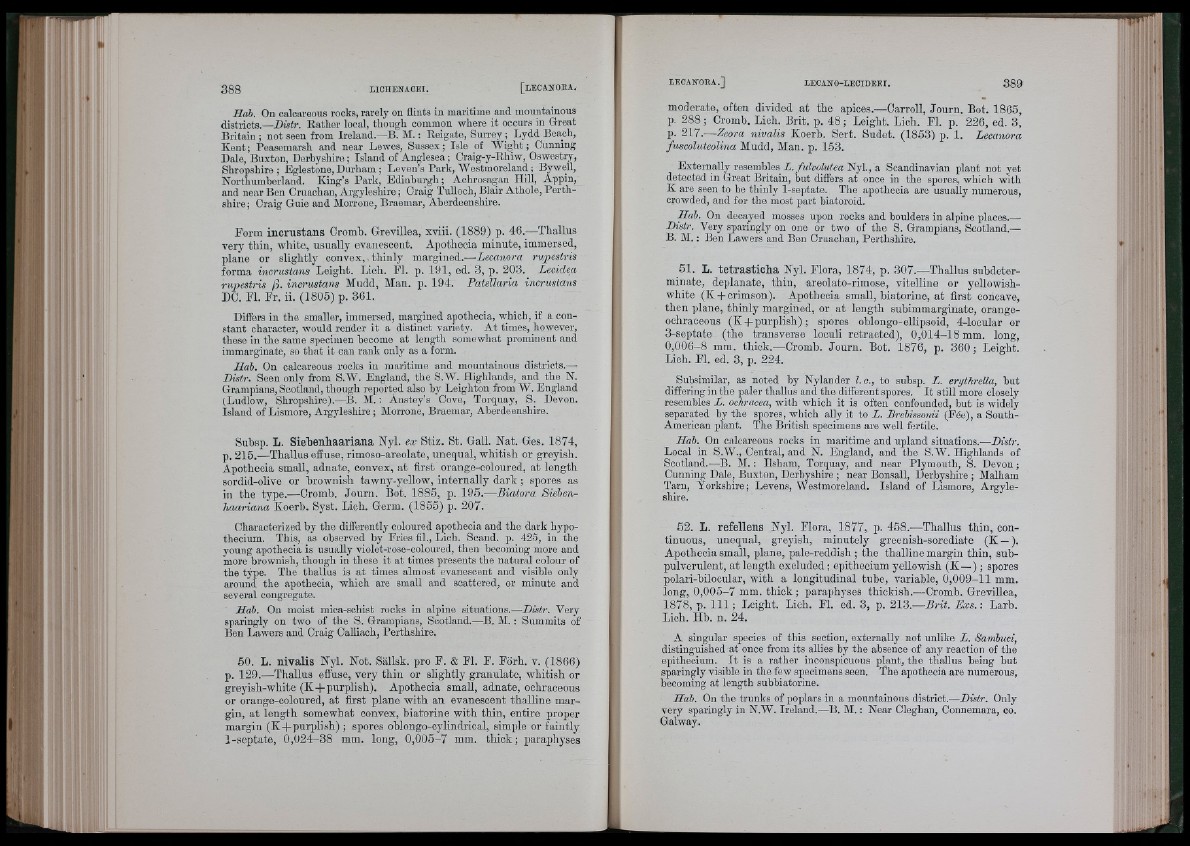
». '
Hah. On calcareous rocks, rarely on flints in maritime and mountainous
districts.—Histr. Rather local, though common where it occurs in Great
Britain ; not seeu from Ireland.—B. M .: Reigate, Surrey Lydd Beach,
K e n t; Peasemarsh and near Lewes, Sussex; Isle of W ig h t; Cunning
Dale, Buxton, Derbyshire; Island of A nglesea; Craig-y-Rhiw, Oswestry,
Shropshire; Ilglestone, Durham ; Leven’s Park, Westmoreland; Bywell,
Nortliumberland. King’s Park, Edinburgh; Achrosagan Hill, Appin,
and near Ben Cruachan, A rgyleshire; Craig Tulloch, Blair Athole, Perthshire;
Oraig Guie aud Morrone, Braemar, Aberdeenshire.
Eorm incrustans Cromb. Grevillea, xviii. (1889) p. 46.—Thallus
very th iu , white, usuaUy evanescent. Apotheoia miuute, immersed,
plane or slightly convex, ■ th in ly margined.— Lecanora rupestris
forma incrustans Leight. Lich. F l. p. 191, ed. 3, p. 203. Lecidea
rupestris ¡3. incrustans Mudd, Man. p. 194. Patellaria incrustans
DC. Fl. F r. ii. (1805) p. 361.
Differs in the smaller, immersed, margined apothecia, which, if a constant
character, would render it a distinct variety. At times, however,
these in the same specimen become at length somewhat prominent and
immarginate, so th a t it can rank only as a form.
Hah. On calcareous rocks iu maritime and mountainous districts.—
Histr. Seen only from S.W. England, the S.W. Highlands, and the N.
Grampians, Scotland, though reported also by Leighton from W . England
(Ludlow, Shropshire).—B. M .; Austey’s Cove, Torquay, S. Devon.
Island of Lismore, Argyleshire; Morrone, Braemar, Aberdeenshire.
Subsp. L. S ie b e n h a a ria n a Nyl. ex Stiz. St. Gall. Nat. Ges. 1874,
p. 215.—Thallus effuse, rimoso-areolate, unequal, whitish or greyish.
Apotheoia small, adnate, convex, a t first orange-coloured, a t length
sordid-olive or brownish tawny-yellow, in te rn a lly dark ; spores as
in th e type.—Cromb. Journ. Bot. 1885, p. 195.— Biatora Sieben-
haariana Koerb. Syst. Lich. Germ. (1855) p. 207.
Characterized by the differently coloured apothecia and the dark hypothecium.
This, as observed by Fries fil., Lich. Scaud. p. 425, iu the
youug apothecia is usually violet-rose-coloured, then becoming more and
more brownish, though in these it at times presents the natural colour of
the type. The thallus is at times almost evanescent aud visible only
around the apothecia, which are small and scattered, or miuute and
several congregate.
Hah. On moist mica-schist rocks in alpine situations.—Histr. Very
sparingly on two of the S. Grampians, Scotland.—B. M .: Summits of
Ben Lawers and Craig Calliach, Perthshire.
50. L. nivalis Nyl. Not. Sallsk. pro F. & F l. F. Forh. v. (1866)
p. 129.—Thallus effuse, very th in or slightly granulate, whitish or
greyisb-white (K + p u rp lis h ). Apotheoia small, adnate, oohraceous
or orange-coloured, a t first plane with an evanescent th allin e margin,
a t length somewhat convex, biatorine with thin, entire proper
margin (K + p u rp lish ); spores oblongo-cylindrical, simple or faintly
1 -septate, 0 ,0 2 4 -3 8 mm. long, 0 ,0 0 5 -7 mm. th io k ; paraphyses
C i v
moderate, often divided a t th e apices.— Carroll, Journ. Bot. 1865,
p. 288 ; Cromb. Lioh. Brit. p. 48 ; Leight. Lich. Fl. p. 226, ed. 3,
P- 217.—Zeora nivalis Koerb. Sert. Sudet. (1853) p. 1. Lecanora
fuscoluteolina Mudd, Man. p. 153.
Externally resembles L. fulvolutea Nyl., a Scandinavian plant not yet
detected iu Great Britain, but differs at once in the spores, which with
K are seeu to be thinly 1-septate. The apothecia are usually numerous,
crowded, and for the most part biatoroid.
Hah. On decayed mosses upon rocks and boulders in alpine places.—
Histr. Very sparingly ou one or two of the S. Grampians, Scotland.—
B. M. ; Beu Lawers and Ben Cruachan, Perthshire.
51. L. tetrasticha Nyl. Flora, 1874, p. 307.—Thallus suhdetor-
minate, deplanate, th iu , areolato-rimose, vitelline or yellowish-
white (K +crimso n ). Apothecia small, biatorine, a t first concave,
th en plane, th in ly margined, or a t length subimmarginate, orange-
ochraceous (K + purplish) ; spores oblongo-ellipsoid, + lo c u la r or
3-septate (the transverse loculi retracted), 0 ,0 1 4 -1 8 mm. long,
0 ,0 0 6 -8 mm. thiok.— Cromb. Jo u rn . Bot. 1876, p. 3 6 0 ; Leight.
Lich. F l. ed. 3, p. 224.
Subsimilar, as noted by Nylander I.e., to subsp. Z. erythrella, but
differing in the paler thallus and the dilierent spores. I t still more closely
resembles Z. ochracea, with which it is often confounded, but is widely
separated by the spores, which ally it to Z. Brehissonii (Fée), a South-
American plant. The British specimens are well fertile.
Hah. On calcareous rocks in maritime and upland situations.—Histr.
Local in S.W., Central, and N. England, and the S.W. Highlands of
Scotland.—B. M. : llsham, Torquay, and near Plymouth, S. Devou ;
Cunning Dale, Buxton, Derbyshire ; near Bonsall, Derbyshire ; Malham
Tarn, Yorkshire; Levens, Westmoreland. Island of Lismore, Argyleshire.
52. L. refellens Nyl. Flora, 1877, p. 458.— Thallus thin, continuous,
unequal, greyish, minutely greenish-sorediate (K — ).
Apotheoia small, plane, pale-reddish; th e thalline margin th in , subpulverulent,
a t length excluded ; epitheoium yellowish (K—) ; spores
polari-bilocular, w ith a longitudinal tube, variable, 0,0 0 9 -1 1 mm.
long, 0 ,0 0 5 -7 mm. thick : paraphyses thiokish.—Cromb. Grevillea,
1878, p. I l l ; Leight. Lich. F l. ed. 3, p. 213.—HHi. Exs. : Larb.
Lioh. Hb. n. 24.
A singular species of this section, externally not unlike Z. Sambuci,
distinguished at once from its allies by the absence of any reaction of the
epithecium. I t is a rather inconspicuous plant, the thallus being but
spariugly visible in the few specimens seeu. The apothecia are numerous,
becoming at length subbiatorine.
Hab. On the truuks of poplars in a mountainous district.—Histr. Only
very sparingly in N.AV. Ireland.—B. M. ; Near Cleghan, Connemara, co.
Galway.